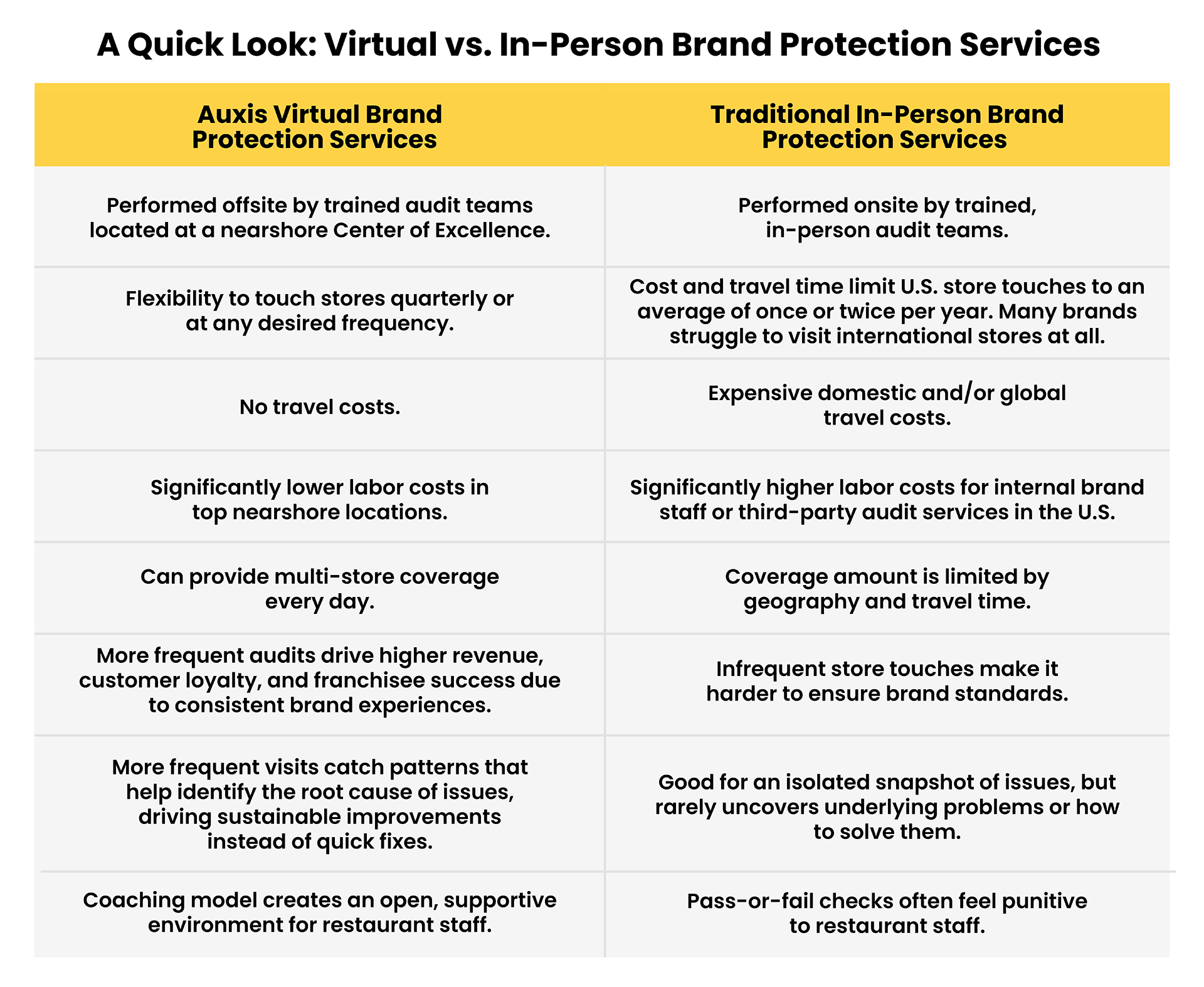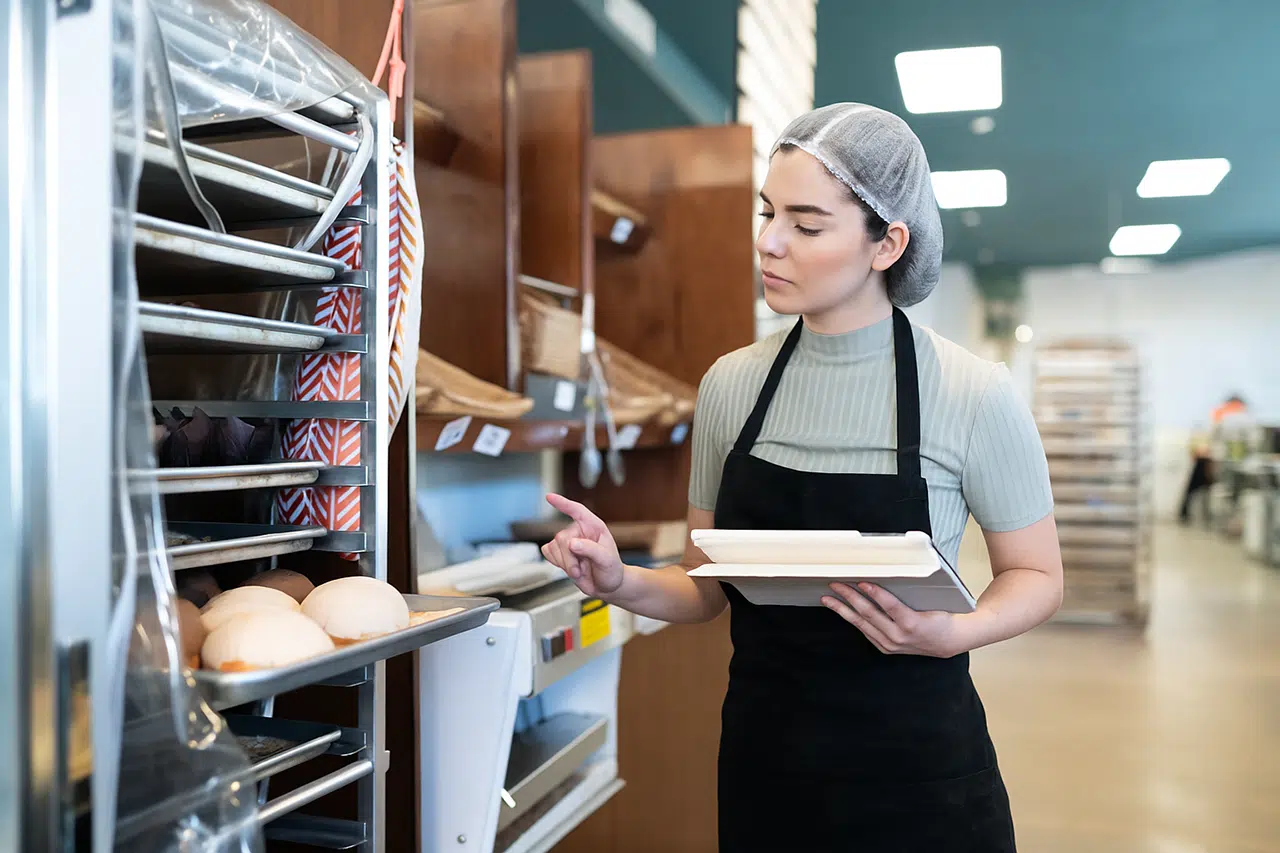In brief:
- Food safety is critical to protecting brand trust and loyalty — a single incident can erase years of reputation and drive guests away.
- Traditional food safety audits tend to be costly, infrequent, and reactive, leaving restaurants vulnerable to overlooked risks and unable to sustain high food safety standards consistently.
- Virtual food safety auditing provides a smarter, tech-enabled alternative, enabling more frequent visits, proactive problem-solving, consistent standards, and stronger compliance at a lower cost.
- Food safety audits are a vital part of the comprehensive virtual operational audit approach that’s transforming the restaurant industry — making store visits more frequent, cost-effective, and impactful. This modern model delivers real-time feedback, practical coaching, and ensures consistent operational excellence across all locations.
Food safety has always been a non-negotiable pillar of success in the restaurant industry. Guests expect commitment to high standards, with food safety compliance directly tied to brand trust and long-term loyalty.
An alarming 48 million Americans get sick from foodborne illnesses each year, leading to 128,000 hospitalizations and 3,000 deaths (Centers for Disease Control and Prevention, 2024). Restaurants are the biggest culprit – accounting for more than half of foodborne illnesses, according to CDC data.
This staggering reality, combined with the fact that a single lapse can go viral overnight and erode consumer confidence built over the years, makes the stakes high. While traditional in-person food safety audits have long been the standard, the rise of digital tools now makes it possible to implement a more robust, proactive model that better supports consistency, speed, and sustained safety across every location.
Restaurant brands that want to stay ahead need a smarter, tech-enabled approach that enables more frequent oversight, empowers frontline teams to uphold food production standards, and helps protect both customer experience and long-term loyalty.
In this article, we’ll explore:
- Why traditional in-person audits are not enough.
- How virtual audits covering food safety, branding, product quality, crew members, kitchen, dining area, and restaurant exterior are transforming restaurant operations.
- How leading restaurant brands are using virtual store visits to strengthen consistency and deliver on their brand promise.
Why is food safety important to the food industry?
While guests may not see every behind-the-scenes protocol, they notice signs of solid restaurant food safety: spotless dining areas, clean bathrooms, and meals that leave them feeling good, not sick. Any slip in these visible cues, or worse, an outbreak of illness, can shatter hard-earned trust and loyalty overnight.
The devastating E. coli outbreak at Chipotle is a powerful reminder of the importance of food safety and what can happen when food safety problems go unchecked. The food brand nearly collapsed, losing customer trust and suffering a 30% plunge in sales nationwide.
Yet through rigorous food safety and compliance improvements and a renewed commitment to operational excellence, Chipotle transformed itself into one of the most profitable restaurant brands today. In 2024 alone, Chipotle reported record annual revenue of $11.3 billion, up 14.6% in 2023, with sales rising by 7.4% — proof that strong restaurant food safety practices do not only protect but can revive a brand.
The limitations of traditional food safety audits
Traditional in-person visits have long been the default approach for restaurant food safety auditing. They offer thorough physical observation that, in theory, should ensure compliance.
However, these audits are typically infrequent, happening only a few times a year due to the cost and logistical challenges of executing them. Such infrequency leads to “performance peaks and troughs,” where stores improve around the time of the audit, but standards quickly decline afterward.
In-person food safety audits focus on compliance in isolated snapshots. While they may catch food safety violations, they rarely uncover the root cause or help solve it. These infrequent visits flag symptoms rather than addressing food safety management system gaps, making it hard for brands to drive sustainable improvements or foster a culture of accountability.
In-person restaurant visits can also be overwhelming for managers and team members. Instead of empowering teams, they become high-pressure, pass-or-fail exercises that create stress and resistance, with managers focused on immediate food safety and compliance rather than long-term operational growth and learning.
Most importantly, traditional restaurant audits lack the ongoing coaching and guidance needed to address the challenges to food safety and drive lasting behavioral change. Without continuous feedback and support, brands miss the opportunity to build stronger safety habits that meet evolving food safety regulations and guest expectations.
Traditional audits are also reactive by nature. Many brands only learn about food safety violations after a customer complaint or, worse, an illness outbreak.
Yet, it only takes one bad experience for 51% of customers to never return to a brand.
Source: 2024 QSR magazine report.
Without continuous oversight, issues often remain hidden until guest trust is compromised. This gap highlights the urgent need for a proactive, technology-enabled food safety strategy.
Virtual food safety auditing: A better way to protect your brand
A virtual food safety audit flips the traditional model. Instead of relying on costly, occasional in-person visits, restaurants can conduct frequent, focused virtual audits with a much more efficient cost model, allowing brands to be “in-store” more often without the logistical and travel burdens of site visits.
But virtual audits are often misunderstood. A common myth about virtual food safety visits is that operators can “hide” issues more easily. In reality, the increased frequency of visits and the real-time video model create a more open, supportive environment.
Staff are less anxious and more forthcoming because they see these audits as ongoing coaching rather than punitive, pass-or-fail checks.
Another misconception is that poor Wi-Fi or weak cellular signals will compromise audit quality. But experience has shown that modern networks are more than capable of supporting strong, stable videos even across large, complex, and international footprints.
More than just a compliance tool, virtual audits deliver a comprehensive evaluation of store operations. They’re tailored to your brand’s standards – spanning branding; food safety such as handling, preparation, and cleanliness; food storage; speed of service; restaurant appearance; and other essential areas.
Here are the key benefits that make virtual audits such a powerful tool for modern food safety:

More frequent visits
A major advantage of virtual audits is the ability to achieve higher visit frequency at a lower overall cost. This more efficient cost model enables brands to shift from occasional in-person visits to a consistent cadence of targeted visits that help catch and correct issues before they escalate.
This shift from reactive “firefighting” to proactive problem-solving helps stores maintain high standards and avoid the performance dips that often follow less frequent traditional audits. When cleanliness, food safety, and overall execution are monitored consistently, guests experience a higher level of confidence and satisfaction every time they walk in.
As Jim Holthouser, CEO of GoTo Foods (previously Focus Brands), noted in his article, “Cracking the International Code,” more frequent, high-quality brand execution made possible by virtual audits directly drives revenue improvement.”
The result for GoTo Foods, according to the article: Overall customer satisfaction scores hit 98% and sales increased 8.5–12.5% at stores included in the virtual coaching program, compared to those that were not.
Tech-enabled, data-driven oversight
At the heart of Auxis’ virtual audit model is advanced, proprietary orchestration software transforming food safety oversight.
Unlike the traditional auditing model, which relies on static schedules, Auxis’ tools create a dynamic, real-time, and data-driven approach to quality control for food safety. It leverages digital triggers such as customer complaints, operational anomalies, and previous audit scores to prioritize high-risk locations.
It also uses intelligent business logic and real-time data to determine when and why each visit should happen. For example, if a store scores poorly in a critical food safety compliance area, a targeted follow-up visit can be automatically scheduled, sometimes within 72 hours, to ensure quick resolution.
Auxis’ tools can also tailor visits to operational needs like new menu launches, seasonal promotions, or updated food safety regulations.
Video documentation from each audit becomes a valuable resource for analysis, coaching, and AI-powered insights — helping brands detect issues faster, personalize training, and strengthen overall processes, leading to improved efficiency and better protection of public health.
Interactive coaching that turns audits into growth opportunities
Auxis’ virtual audits mirror in-person checks, but enhance them with live, interactive coaching. During a session, store managers might prepare menu items step by step on video, while trained specialists observe every detail in real time.
Instead of simply pointing out mistakes, auditors engage managers with reflective questions like, “What went well?” and “What can we improve?” This hands-on guidance empowers managers to self-assess, deepening their understanding of food safety standards and compliance, while building their confidence as leaders.
By fostering a “teach to fish” mindset, virtual audits help brands develop local leaders who can coach their own teams, sustain improvements, and create a culture of shared accountability.
For example, in a multi-year initiative with a global restaurant brand, Auxis conducted 2,700+ virtual audits across 1,000+ locations, delivering real-time coaching through its Costa Rica shared services team.
This scale not only ensured compliance but also improved operational execution and guest experience.
Consistent and centralized standards
Another advantage of virtual audits is the consistency they deliver across locations. In traditional in-person audits, results can vary depending on who conducts the visits. Each auditor may interpret standards or scoring differently, leading to uneven application of food safety management protocols and brand standards.
With virtual audits, evaluations are carried out by a centralized, shared services team using standardized training, unified processes, and video evidence reviewed by a dedicated quality assurance function. That way, every location is held to the same high standards, each time.
Centralized data also plays a critical role in brand consistency. Virtual audits generate clear, comparable insights that give brands a holistic view across their locations.
The shared data enables leaders to spot trends, prioritize support, and align teams more effectively. Brands will be able to deliver on their promise every time, no matter where diners choose to eat, leading to guest trust and loyalty.
The hybrid restaurant audit approach
While fully virtual audits offer compelling benefits, moving entirely away from in-person checks can feel daunting for some brands. The good news? You don’t have to make an all-or-nothing leap.
Many brands start by introducing more frequent virtual visits, complemented by occasional on-site audits to build comfort and confidence. Over time, as they see stronger results and more consistent execution, they often find they can further reduce costly physical visits and embrace virtual audits completely.
Why Auxis: Redefining food safety for restaurants
Consumers paying higher, inflation-driven menu prices are demanding more than just great food – they expect maximum safety, consistent quality, and full confidence in the brands they support. Relying solely on costly and infrequent in-person food safety audits is no longer enough to meet these expectations or mitigate risk at scale.
Virtual operational audits offer a smarter path forward: tech-enabled, data-driven, coaching-led, they allow brands to detect and address food safety issues earlier, drive excellence across every component of store operations, and build more capable, confident restaurant teams.
Virtual visits don’t just replicate in-person inspections, they enable a shift toward continuous improvement and long-term guest trust.
At Auxis, we partner with leading restaurant brands to build modern restaurant operations that are consistent, scalable, and aligned to brand goals. From real-time video audits to intelligent scheduling and coaching-led feedback loops, we help turn food safety – and broader operational excellence – into a true driver of impeccable guest experience and brand loyalty.
Ready to elevate your food safety strategy and deliver a safer, more consistent guest experience with virtual restaurant auditing? Connect with our Restaurant Services experts or explore our restaurant industry success stories, including what Blaze Pizza’s CEO had to say about the real impact of virtual store checks.
Frequently Asked Questions
What are the basics of food safety?
What is the golden rule of food safety?
What are the top challenges in food safety today?
What is a virtual food safety audit?
What is the importance of food safety in restaurants?


